
The top 25 sights in the USA
11. Joshua Tree
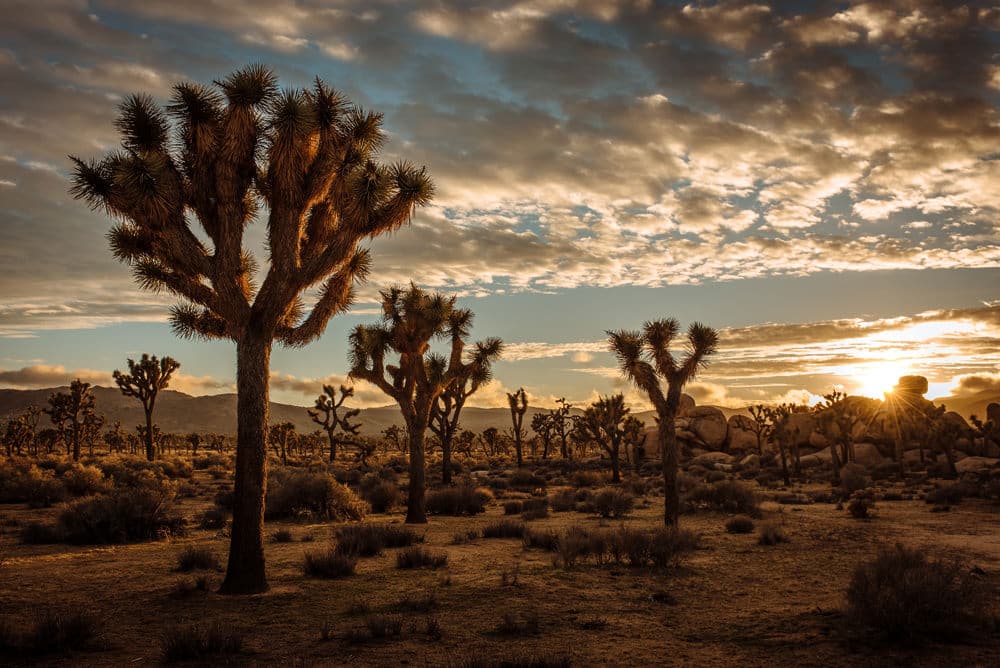
Joshua Tree National Park is located in south-eastern California, a good 200 kilometers east of Los Angeles and 600 kilometers west of the Grand Canyon. Joshua Tree National Park is particularly worth a visit because the otherwise barren desert landscape is dotted with the unusual Joshua Trees (Joshua palms). But beautiful hiking trails and the odd view also make this park something special.
There are several entrances to the park, usually either via the small town of Joshua Tree in the west or via Twentynine Palms a little further east, where you will also find a visitor center. Because the park is massive, you have to be prepared to travel quite a lot by car, even in the interior.
In contrast to many other national parks, there is no fixed or best sequence to follow in Joshua Tree. Highly recommended are the centrally located Hidden Valley, which is a wonderful place to hike, Barker Dam, which offers a rare view of water in the desert, and Keys View, with a great view that is only sometimes spoiled by the air pollution in the area in the afternoon in summer.
The remains of old mine buildings, which can sometimes be found by the wayside, are also worth a look. Watch out for snakes, some of which crawl through the bushes, and make sure you have enough water — and not just in midsummer.
Trails in Joshua Tree National Park
There are numerous great hiking trails in the park, which is why it is difficult to make a clear recommendation. For beginners, the short trails (around 2 kilometers) to Barker Dam and through Hidden Valley are recommended, and the trail to Skull Rock can also be completed in just over an hour.
If you are looking for something a little longer, we recommend the Lost Horse Mine Trail (6 kilometers), the 49 Palms Oasis Trail (5 kilometers) and Mastodon Peak (also 5 kilometers), for each of which you should plan half a day due to the altitude difference.
Compared to other national parks, however, even the more challenging trails are relatively harmless, only the often extreme heat is a real problem and can pose a real risk in the worst case — don’t overestimate your strength.
Joshua Tree: Where to stay?
In the park itself there are numerous campsites in prime locations and with plenty of space, but understandably, there is a lack of water almost everywhere. If you want to stay in a hotel or motel, we recommend Twentynine Palms at the park entrance. Palm Springs*, which is larger but a little further away, can also be an alternative.
As the Joshua Tree is now world-famous and a real landmark of the United States of America, you should definitely not miss a visit to the national park during your trip to the USA. Even the world-famous rock band U2 has dedicated an entire album to the Joshua Tree.
12. Golden Gate Bridge
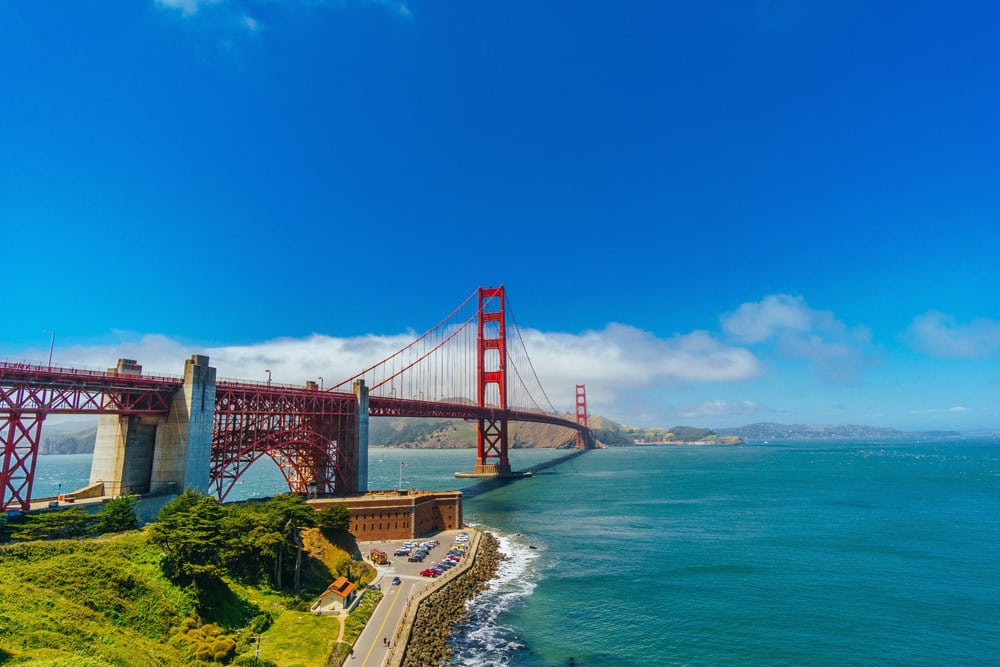
The Golden Gate Bridge is one of the most famous landmarks in the USA. It is a suspension bridge that spans the Golden Gate, the 1.6 km wide strait that connects San Francisco Bay with the Pacific Ocean. The structure connects the US city of San Francisco*, California — the northern tip of the San Francisco Peninsula — with Marin County and carries both US Route 101 and California State Route 1 across the strait. It also serves pedestrian and bicycle traffic and is designated as part of U.S. Bicycle Route 95. Declared one of the Wonders of the Modern World by the American Society of Civil Engineers, the bridge is one of the most internationally recognized symbols of San Francisco and California. It was originally designed by engineer Joseph Strauss in 1917.
The travel guide Frommer’s describes the Golden Gate Bridge as “possibly, the most beautiful and certainly the most photographed bridge in the world”. At the time of its opening in 1937, it was both the longest and the world’s highest suspension bridge, with a main span of 1,280 meters and a total height of 227 meters.
Utilization and tourism
The bridge is very popular with pedestrians and cyclists. It was built with sidewalks on both sides of the six lanes for car traffic. Originally, they were separated from the traffic lanes only by a metal curb, but in 2003 railings were installed between the sidewalks and the traffic lanes — primarily to prevent cyclists from falling onto the roadway. The bridge was designated as part of U.S. Bicycle Route 95 in 2021.
The main walkway is located on the east side and is accessible to pedestrians and bicycles on weekdays from the morning until the afternoon (5:00 am to 3:30 pm) and only for pedestrians during the remaining hours of the day (until 6:00 pm or 9:00 pm during summer). The eastern sidewalk is reserved for pedestrians at weekends (5:00 a.m. to 6:00 p.m. or 9:00 p.m. during summer) and is only accessible to cyclists in the evening and at night when it is closed to pedestrians. The western sidewalk is only open to cyclists at the times when the eastern sidewalk is closed to cyclists.
Bus service across the bridge is provided by two public transportation companies: San Francisco Muni and Golden Gate Transit. Muni offers the Marin Headlands Express bus route on Saturdays and Sundays, and Golden Gate Transit operates numerous bus routes throughout the week. The south end of the bridge, near the toll plaza and parking lot, is also accessible daily from 5:30 a.m. to midnight on Muni Line 28. Marin Airporter, a private company, also provides bridge service between Marin County and San Francisco International Airport.
Tips for visitors to the Golden Gate Bridge
A visitor center and gift store, originally called the “Bridge Pavilion” (now renamed the “Golden Gate Bridge Welcome Center”), is located on the San Francisco side of the bridge, right next to the southeast parking lot. It opened in 2012, in time to celebrate the bridge’s 75th anniversary. Nearby are a café, outdoor exhibits and restrooms. On the Marin side of the bridge, accessible only from the northbound lanes, is the H. Dana Bower Rest Area and Vista Point, named for the first landscape architect of the California Division of Highways.
The land and waters under and around the bridge are home to various wildlife such as bobcats, seals and sea lions. Three species of cetaceans that were absent from the area for many years have recently recovered, or more accurately re-established, near the bridge. Researchers studying them have encouraged greater protection and recommended that the public observe them from the bridge or from land, or use a local whale-watching provider.
Ad
13. Yosemite National Park
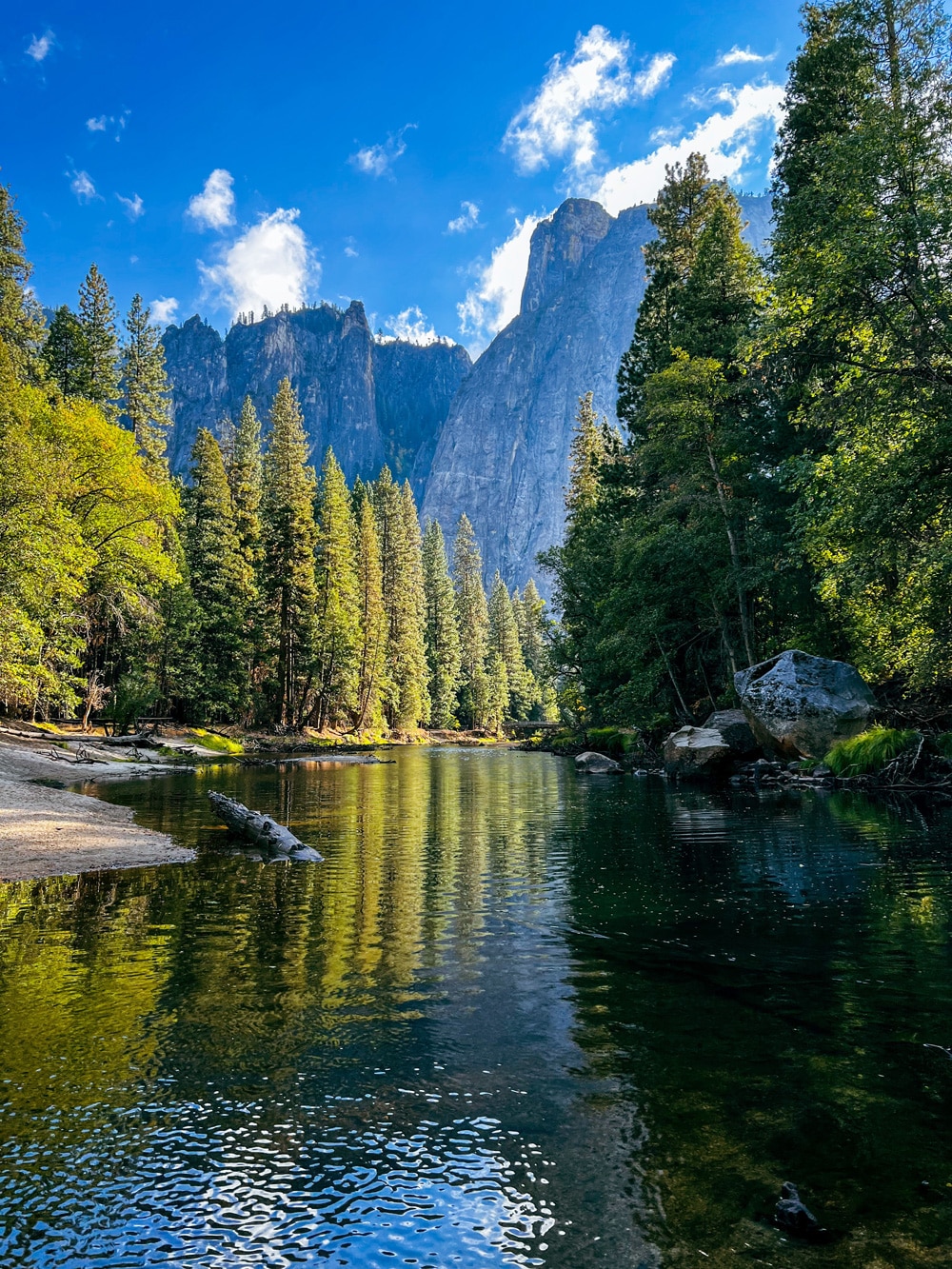
Yosemite National Park is quite centrally located in California, around 270 kilometers east of San Francisco and 500 kilometers north of Los Angeles. It is about 200 kilometers to Sequoia National Park on a difficult road. Yosemite National Park is particularly worth a visit due to its fantastic cliffs, numerous waterfalls, many hiking trails, great views and, finally, several sequoia trees.
The park can be reached from the west via three different access routes: Route 120 via Groveland in the north from San Francisco, Route 140 from San José and Route 141 from Fresno / Los Angeles via Wawona in the south. In the summer months, the access road to the east towards Nevada, the Tioga Pass, is also open. However, its availability is heavily dependent on the weather; only from the beginning of July to mid-September can you be fairly certain that the pass will be passable.
In Yosemite National Park itself, you usually travel by car due to the long distances, but in summer, it is sometimes advisable to take one of the shuttle buses due to the high number of visitors.
The central point of the park is the Yosemite Valley, which boasts impressive rock formations, waterfalls and great views. It is a wonderful place to hike and explore nature — at least as far as tourism allows.
Also well worth a visit are historic Wawona and the Mariposa Grove with its magnificent sequoia trees in the south, Glacier Point with its breathtaking views in Yosemite Valley and Hetch Hetchy in the north, which is similar to the Valley but attracts fewer visitors due to its location.
Before visiting Yosemite, take a look at the current weather and road conditions and read the official information on bears, which are frequently encountered in the park.
Hiking in Yosemite National Park
There are countless hiking trails in the park that offer something for everyone. In Yosemite Valley, we can recommend the short, easy trails to Bridalveil and Lower Yosemite Fall for beginners; the Mirror Lake / Meadow Trail is also suitable for beginners at just under 3 kilometers. The Valley Floor Loop (10 kilometers for half the loop) is more difficult, but also beautiful, while professionals can tackle the Panorama or Upper Yosemite Fall Trail, which are challenging day hikes.
On Glacier Point Road, we recommend the trails to various viewpoints, such as Bridalveil Creek (6 kilometers) and Sentinel Dome (4 kilometers), while in Wawona the trail to Mariposa Grove is worth considering despite being 10 kilometers long. You can also hike between the Giant Sequoias themselves. In Hetch Hetchy, for example, the Wapama Falls Trail (8 kilometers) is said to be beautiful, but we have not yet been able to see it for ourselves.
Yosemite: Where to stay?
There are numerous places to stay in Yosemite National Park itself, such as the old The Ahwahnee in Yosemite Valley and various lodges near the waterfalls or in Wawona. The prices are reasonable, the level of comfort is mixed, but they are, of course, booked out well in advance during the summer months. However, staying overnight outside the park is hardly an alternative due to the long distances.
As is so often the case in national parks, campers have it a little easier in Yosemite and can find numerous good, inexpensive pitches directly in the park, although in summer, these have to be reserved several months in advance.
Ad
14. Grand Central Terminal (New York)
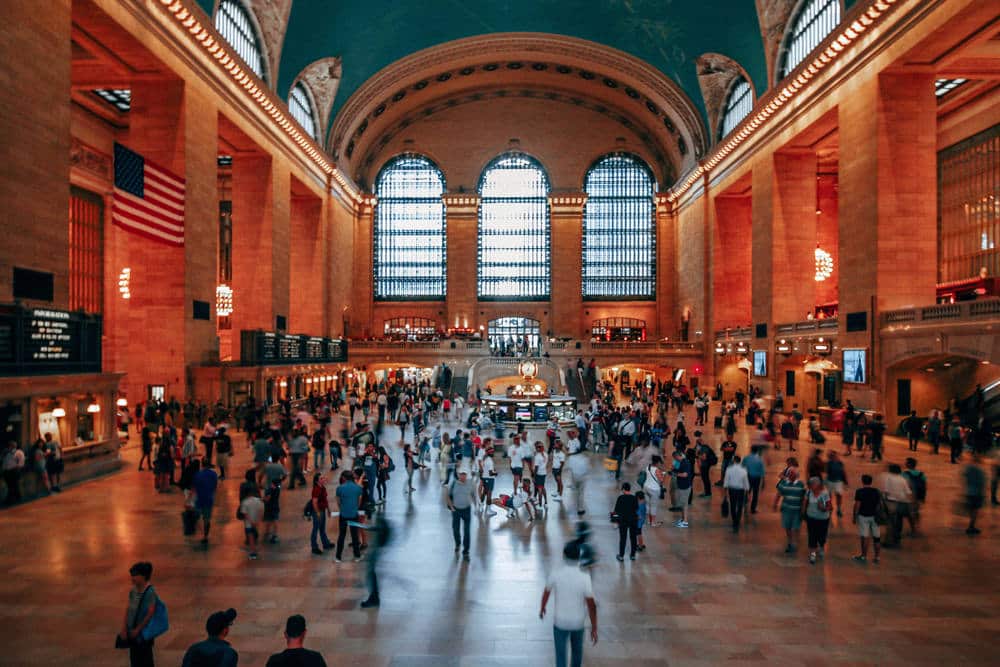
Grand Central Terminal (GCT; also known as Grand Central Station or simply Grand Central) is a mass transit terminal at 42nd Street and Park Avenue in Midtown Manhattan, New York City*. Grand Central is the southern terminus of the Harlem, Hudson, and New Haven Lines of the Metro-North Railroad, which serves the northern parts of the New York metropolitan area. There is also a connection to the New York City Subway at the Grand Central-42nd Street station. The terminal is the second-largest station in North America after New York’s Penn Station.
The unmistakable architecture and interior design of the Grand Central Terminal station building have earned it several awards, including National Historic Landmark status. Numerous works of art can be found in its Beaux-Arts design.
Grand Central Terminal is one of the ten most visited tourist attractions in the world, with 21.6 million visitors in 2018, excluding train and subway passengers. The terminal’s main concourse is often used as a meeting place and is mainly seen in movies and television. Grand Central Terminal is home to various stores and food vendors, including upscale restaurants and bars, two food halls and a food market.
Grand Central Terminal was built by and named after the New York Central Railroad; it also served the New York, New Haven and Hartford Railroad and later the successor companies of the New York Central. Opened in 1913, the terminal was built on the site of two predecessor stations of the same name, the first of which dated back to 1871. Grand Central Terminal served intercity traffic until 1991, when Amtrak began routing its trains through nearby Penn Station. The East Side Access project, which will bring the Long Island Rail Road to a new station below the terminal, is due to be completed by the end of 2022.
Grand Central covers an area of 19 hectares and has 44 platforms, more than any other station in the world. The platforms, which are all underground, serve 30 tracks on the upper level and 26 on the lower level. There are 67 tracks in total, including a marshalling yard and sidings; of these, 43 tracks are used for passenger services, while the remaining two dozen tracks serve as sidings. A further eight tracks and four platforms will be built on two new levels deep below the existing station as part of the East Side Access.
Grand Central primarily impresses visitors with its breathtaking architecture. Therefore, you should definitely not miss a trip to this US landmark!
15. Arches National Park
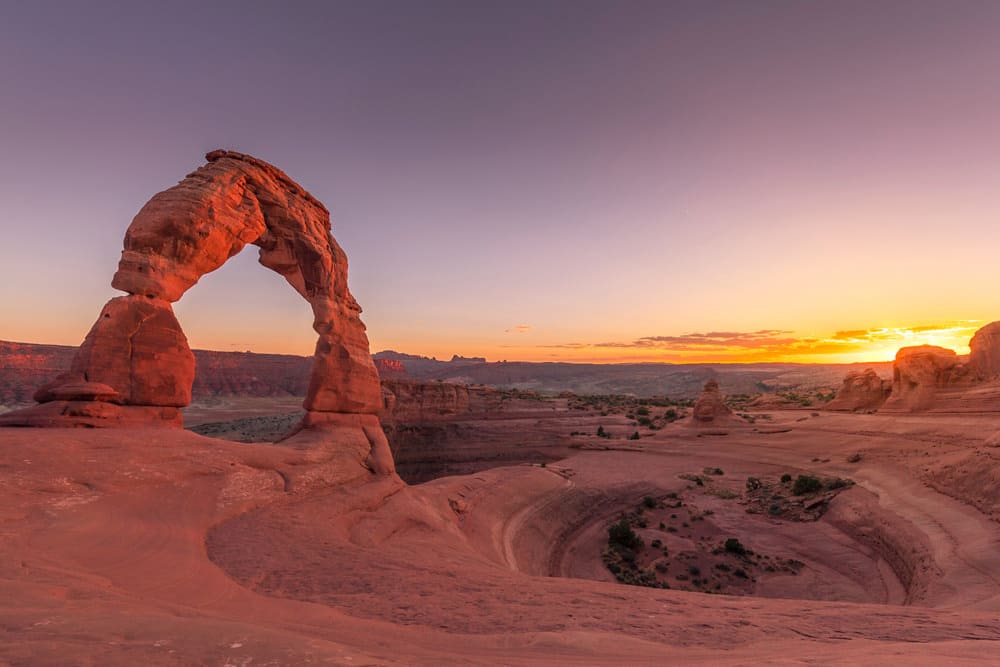
Arches National Park is located in eastern Utah, right next to the small town of Moab, which is the starting point for a visit to Arches and Canyonlands National Park. Particularly worth seeing in Arches National Park are — as the name suggests — of course, the magnificent red stone arches, which come in all shapes and sizes and some of which can only be reached via long, beautiful hiking trails. There really is something for everyone here.
The visitor center is located directly behind the entrance to the park, but this time it is not necessarily worth a stop — you are usually given a map and information material when you enter the park. The long road first leads past several scenic viewpoints and the first beautiful rock formations, including the Tower of Babel and Balanced Rock, which is well-known from many photos.
Only after about 17 kilometers do you reach a junction where you have to make your first decision: to the east are the North and South Windows and the Double Arch, while the route continues straight on to the Delicate Arch and Devil’s Garden.
Everything is worth a visit and the exact itinerary depends on the time of day, the time available and the number of visitors, as Arches National Park is unfortunately often pretty crowded and parking spaces become scarce from midday onwards. Under normal circumstances, we recommend visiting the Windows first in the morning and then heading to Devil’s Garden in the afternoon. On a second day, we recommend visiting the Delicate Arch.
If you only have one day available, drive to Devil’s Garden first and visit the Delicate Arch on the way back — if time is short, you can also just head for its viewpoint. The Windows can be neglected if necessary, although in this case, you would also miss the unique Double Arch.
Hiking trails in Arches National Park
For us, the Devils Garden Primitive Loop, which passes many of the best arches, is an absolute must. In total, the loop is just under 12 kilometers long and usually takes at least four hours to complete. As usual, sufficient water and food are a must, but the trail is not as strenuous as its length would suggest. There are a few slopes, but even those with a fear of heights should be able to manage the trail.
Moreover, highly recommended is the Delicate Arch Trail, which is shorter at just under 5 kilometers, but no less strenuous due to steep inclines and moderate paths. However, it leads to the wonderful Delicate Arch, which can otherwise only be seen from a great distance.
The approximately 2-kilometer trail to Double Arch and the Windows, which has no significant climbs, is suitable for beginners.
Where can you stay overnight in Arches Park?
For campers, there is the Devil’s Garden Campground in the park, but it is small and almost always fully booked well in advance. Both campers and rental car travelers therefore usually spend the night in Moab, which is also the starting point for Canyonlands National Park and offers numerous motels, hotels*, and campsites. As the only real town within a radius of hundreds of kilometers, Moab also has almost everything you need, including large supermarkets and several fast food chains.
Note: Links marked with an asterisk (*) or “Ad” are so-called affiliate links. As an Amazon partner, we earn from qualified sales. The same applies to other partners. This means that we receive a small commission on purchases or bookings to finance this site. There are no additional costs for you!




